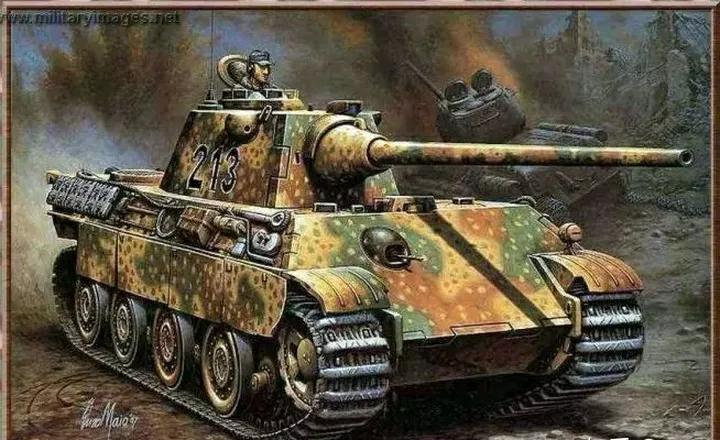Since the British created tanks, there are many kinds of tank designs and tactics. And to the World War II tanks and their related tactics there is a qualitative leap forward. Mainly look at Hans's zoo.
During Hans's blitzkrieg Apo, Yue Ardenne played small law. It has been exposed that the 37mm and 59mm anti-tank guns of their own homes are insufficient. For the British "Matilda" and the French "Charles" B1 heavy tank, the LI and INV are difficult.
In 1940 Hans said that no one knew wool better than I did, and that we could not break it by kicking a foot in the cottage. As a result, a kick to the T34 left Hans with a lack of medium-heavy tanks and anti-tank firepower exposed. To this end Henschelne design technician Erwin. Adler said that "everyone was astonished to know that Maozi's tank was superior to any wehrmacht tank." ”
Leopard tank a mechanical son
In order to counter the Maozi T-34 and replace the Panzer III and IV tanks, the Leopard tank, which was the brainchild of Hans, was commissioned from mid-1943 to 1945.

The Leopard tank refers to some of the Maozi tank design, using 55 inclined armor, which increases the possibility of jumping bullets, increases the thickness of the horizontal direction of the armor, and is not easy to be shot through. As a result, the weight of the tank was increased from an estimated 35 tons to 43 tons, and its armor was made of homogeneous steel plates, which became stronger after welding and locking. In addition, the leopard tank originally produced had only a 60 mm piece of oblique armor, but it was soon thickened to 80 mm. Later models of the Leopard D enhanced the flame tower armor to a ceiling of 120 mm to protect the front end of the gun and a 5 mm thick skirt on both sides of the tank to protect the tank from anti-tank weapons.
The main gun of the Panther tank is the 75 mm semi-automatic KvK42L70 gun produced by Caiyin Metal. It is not a large-caliber gun, but its long barrel and strong propulsion provide it with high-speed firing capabilities. Externally, due to the lower sensitivity of the sights on the tank, it makes it easier for the Panther tank to hit the enemy. Its gun penetration capacity is higher than that of the 88 mm KWK36 L56 gun, and the ammunition: APCBC. He and APCR three. Moreover, in the later stages of the war, after the Luftwaffe lost air superiority, some tanks were also equipped with an MG42 machine gun, which was installed on the smoke tower, which helped to sweep away infantry and anti-aircraft uses.
King of leopards, a Buckman
During the Battle of Normandy on 27 July 1944, Buckman Middle-earth and his Panther tanks, part of the Imperial SS Panzer Division, were in pursuit of the large forces. On the way, 15 U.S. M4 Sherman tanks and a group of trucks were spotted approaching along the road. Buckman parked his tank at the intersection, single-handedly blocked the U.S. army's way, and destroyed 9 U.S. Sherman tanks and several trucks in the ensuing battle. Tom calls for a fighter plane to come to the rescue, which injures Buckman's Panther tank with an aerial bomb. In the end, Buckman calmly retreated and was awarded the Knight's Cross of the Iron Cross afterwards.
Tiger tank a big cat out of the cage
Tiger mainly looks at Porsche and Henscher, because Porsche failed mainly looked at Henschel, but Porsche has a characteristic" The power generated by the outer suspension system and the engine drives the generator to generate electricity, and the power is transmitted to two motors to drive the start wheel and change gear speed, similar to automatic gearing, which can reduce stress impact. Porsche was later changed to an Elephant self-propelled gun
Enjoy the Schell "tiger" style
After Henschel designed dw.IA in 1939, Henschel made the D.W.2 but did it for economic reasons.
In May 1941, Henschel proposed a design for the VK4501(H). Krupp's 88mm KwK38 L/56 tank gun was fitted with the Carl Zeiss TFZ 9b sight. Using the Maybach V-12-cylinder HL230 P45 23-liter 700 hp, the armor is mostly vertically connected to other structures and adopts the form of bite connection, and the bite armor is entrained (rather than riveted). It uses some of the results of the previously developed 30-ton tank. A performance demonstration was given on April 20, 1942 (the birthday of the old Hee).
tiger! tiger! tiger! A Wittmann
On June 13, 1944, the 2nd Company of the 101st Regular Tank Battalion commanded by Wittmann was left with only 4 Tiger tanks and 1 Panzer IV from Beauvais to the village of Pokaki. Halt the advance of the British 7th Panzer Division, defend the flanks of the German Panzer Division and keep the road to Kajon open. At 8 a.m., his tank company set its sights on a British armoured column advancing on a sunken road near the village of Pokaki, and Wittmann waited until the convoy was less than 100 meters away from him before firing, and first destroying the first and last vehicles, blocking the way for the British to flee. Under the cover of a small grove of trees, Wittmann first blew up one of the British first half-box belt cars, then the last one, and then named the British tanks one by one with 88 mm guns. In just 5 minutes of this tense and exciting time, Wittmann's company sent 25 Cromwell and Firefly tanks of the 4th Lun Order of the 22nd Panzer Brigade of the British 7th Panzer Division into the sky, as well as 14 half-track vehicles and 14 Buren universal vehicles, unscathed since 2.